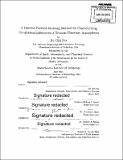| dc.contributor.advisor | Richard P. Binzel, Amanda S. Bosh and Michael J. Person. | en_US |
| dc.contributor.author | Siu, Ho Chit | en_US |
| dc.contributor.other | Massachusetts Institute of Technology. Department of Earth, Atmospheric, and Planetary Sciences. | en_US |
| dc.date.accessioned | 2015-09-17T19:04:12Z | |
| dc.date.available | 2015-09-17T19:04:12Z | |
| dc.date.copyright | 2015 | en_US |
| dc.date.issued | 2015 | en_US |
| dc.identifier.uri | http://hdl.handle.net/1721.1/98677 | |
| dc.description | Thesis: S.M., Massachusetts Institute of Technology, Department of Earth, Atmospheric, and Planetary Sciences, 2015. | en_US |
| dc.description | Cataloged from PDF version of thesis. | en_US |
| dc.description | Includes bibliographical references (pages 108-110). | en_US |
| dc.description.abstract | We present a discrete numerical approach for forward-modeling lightcurves from stellar occultations by planetary atmospheres. Our discrete approach provides a way to arbitrarily set atmospheric properties at any radius from the occulting body, giving it flexibility for applying models of vertical variation in atmospheric conditions. The method is used to examine trends in lightcurve characteristics resulting from changes in the atmosphere of the occulting body. We find that for Pluto-like atmospheres, temperature and pressure variations affect the characteristics of the lightcurve much more than the gas composition. We also find that the half-light radius is more sensitive to atmospheric changes than either the minimum normalized flux or the slope at half-light. Temperature is found to be the most easily-constrained atmospheric parameter, as the gradients for changes in lightcurve characteristics are much more aligned with the temperature axis of the atmospheric parameter space than any other axis. Trends in lightcurve characteristics were examined in and around the parameter space occupied by the atmospheric conditions predicted for Pluto based on the 2011 and 2013 occultation events. Our error analysis method produced uncertainty values consistent with the reported uncertainties for half-light radius. This kind of lightcurve characterization is potentially useful for constraining the level of precision required in measuring given lightcurve characteristics in order to provide certain uncertainty bounds on the atmospheric conditions of the occulting body. | en_US |
| dc.description.statementofresponsibility | by Ho Chit Siu. | en_US |
| dc.format.extent | 110 pages | en_US |
| dc.language.iso | eng | en_US |
| dc.publisher | Massachusetts Institute of Technology | en_US |
| dc.rights | M.I.T. theses are protected by copyright. They may be viewed from this source for any purpose, but reproduction or distribution in any format is prohibited without written permission. See provided URL for inquiries about permission. | en_US |
| dc.rights.uri | http://dspace.mit.edu/handle/1721.1/7582 | en_US |
| dc.subject | Earth, Atmospheric, and Planetary Sciences. | en_US |
| dc.title | A discrete forward-modeling method for characterizing occultation lightcurves of tenuous planetary atmospheres | en_US |
| dc.type | Thesis | en_US |
| dc.description.degree | S.M. | en_US |
| dc.contributor.department | Massachusetts Institute of Technology. Department of Earth, Atmospheric, and Planetary Sciences | |
| dc.identifier.oclc | 920682604 | en_US |
